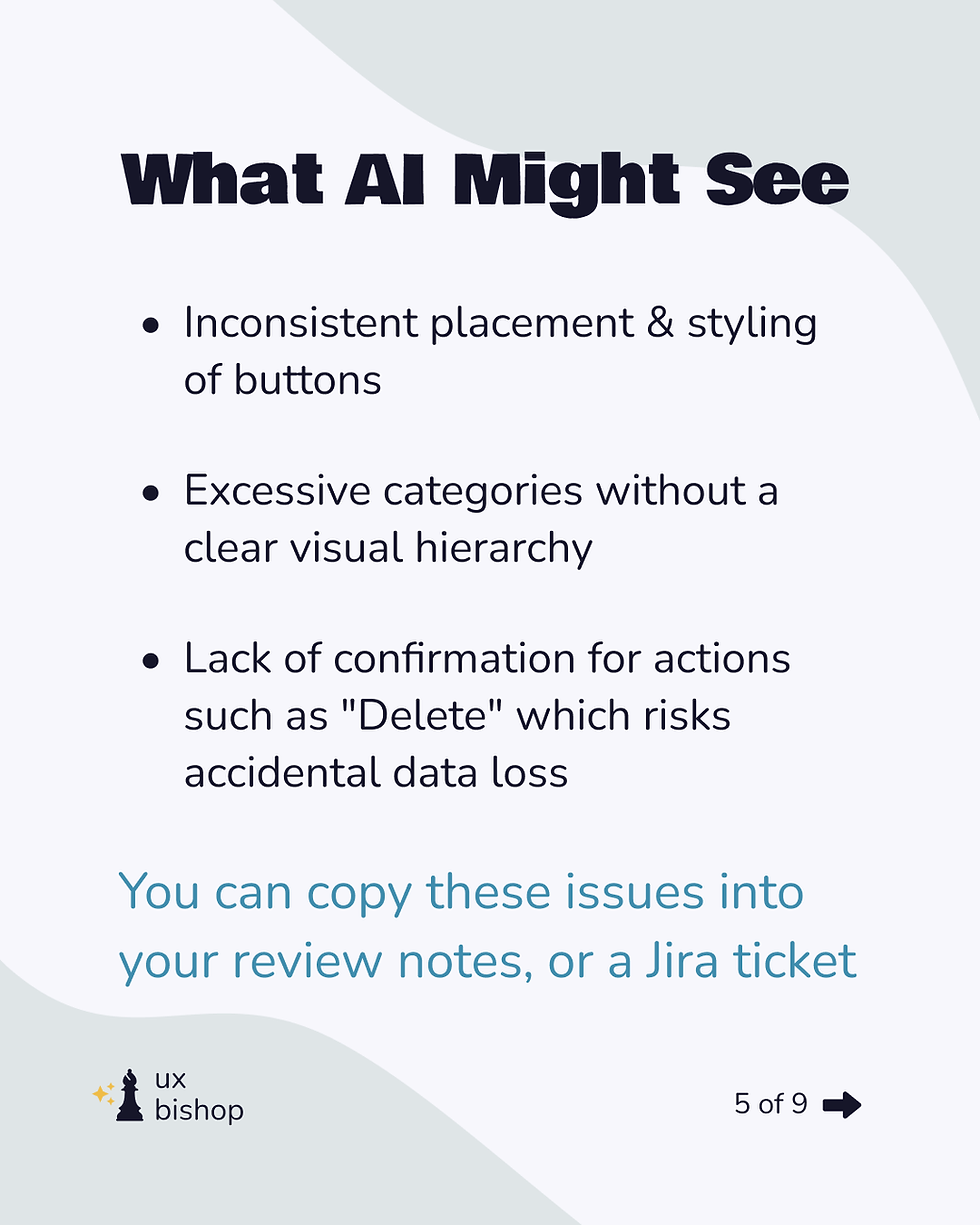Using AI for Quick Usability Feedback - Midgame Moves
- architette

- Jul 24
- 4 min read
Updated: Oct 13

TLDR version:
Need a fast gut check on usability when you’re mid-sprint? Here’s a lightweight method I’ve found helpful:
My Quick Process:
• Grab a screenshot of your UI/mockup
• Scrub it! Remove logos or anything confidential*
• Upload it to your company approved AI chat tool
• Ask it to review using Nielsen’s usability principles
• Use the feedback to tighten your design before reviews
Imagine you're midway into a sprint, and your PM just asked if the new feature is "intuitive enough." You start second guessing everything. Sound familiar? 😅
I’m sure every seasoned UX designer has been there before… caught in that classic mid-sprint squeeze where you need to move fast but can't afford to ship something that'll have users scratching their heads. The good news is AI is your new newest design co-worker, and it’s always on standby.

Step 1: Capture the Moment
Grab a screenshot of whatever you're working on. High-fidelity mockup? Perfect. Rough wireframe that looks like it was drawn by a caffeinated squirrel? Also perfect. AI doesn't judge your artistic skills.
Scrub it! This is the "treat it like classified documents" step. Black out company names, logos, user data, or anything that would make your legal team setup a meeting with you.

Step 2: Get Your AI Second Opinion
Upload it to your company approved AI chat tool and prompt it as light or heavy as you wish you have AI explain. My go-to for a lightweight check is “Evaluate this UI using Nielsen’s 10 heuristics. Highlight 3 things that may break usability.”

Step 3: Use the Feedback
Using the feedback AI returns… you can refine microcopy, standardize button placement, group related items, or maybe a variety of updates of a different flavor. You can copy these updates into review notes, or in a Jira ticket… however your team works best! Don’t just copy & paste what AI says… use the feedback to spark your UX expertise. It helps to ask “Would I give this same feedback to a junior designer?”


Why This Actually Works
It’s a quick way to catch obvious issues before they snowball into bigger, more expensive rework. AI isn’t replacing UX design expertise, but it IS a helpful second set of “eyes” during fast-paced builds.

The Surprising Benefits
It's faster than your morning coffee routine. AI can tear through a heuristic evaluation in seconds.
It doesn't have design ego. AI will sometimes cheerfully tell you when something sucks but it really has no hurt feelings, no dramatic sighs, just straight talk about your interface.
It teaches you things. Use this enough, and you'll start catching issues before AI does. It's like having a really patient mentor who doesn't mind repeating themselves. When AI catches something you missed, don't just fix it and move on. Ask yourself why you missed it. Understanding your blind spots makes you a better designer.

Keeping Corporate Happy
Redact like your job depends on it (because it might). Company names, user data, proprietary stuff – black it all out. When in doubt, redact it out.
Check your tool allowlist. Some companies are cool with AI tools, others treat them like digital radioactive material. Know which camp you're in.
Document everything. Keep notes about what you redacted and which tools you used. Future you (and your compliance team) will thank you.
Real Talk: What AI Can't Do
AI sees your screenshot but doesn't know that weird button placement was actually a previous business decision based on user research. Context matters, and AI doesn't have it.
AI recommendations are like horoscopes – generally applicable but not specifically tailored to your unique situation. "Improve your navigation" is helpful, but it's not going to solve your specific user flow problem.
Most importantly, AI knows the rules but doesn't understand user emotions, frustrations, or that moment when someone throws their phone because your checkout process has 47 steps.
Making This Work in Real Life
Don't treat this like a special occasion tool. Make it part of your regular routine – after wireframes are done, before stakeholder reviews, right before dev handoff, or when updating your design system.
AI isn't going to replace your creativity, your user empathy, or your ability to translate business requirements into elegant solutions. But it can be that reliable second pair of eyes.
AI Co-worker = Hired!
You can start using this approach with AI today. No need to wait for HR to sign off on the final onboarding documentation for your newest “intern.” Find out what your enterprise allows in the world of AI chats, and upload a screenshot of a design in the works. You might be surprised. The worst thing that happens is you waste five minutes. The best thing? You catch that usability issue before it becomes a user complaint.
If AI helps you avoid even one "why didn't we think of that earlier?" moment, it's already paid for itself!
---
*Got any stories about AI catching design issues you missed? Or maybe you've found other creative ways to make AI useful in your design process? I'm always curious about how other designers are making this stuff work in the real world. Send me a message!
… and before you ask, yes… I wrote this post with the help of AI but heavily edited just about every line so it is more of myself. 😉

Disclaimer: The thoughts shared in this blog are solely my own and do not represent the perspectives of my professional relationships or clientele.
Comments